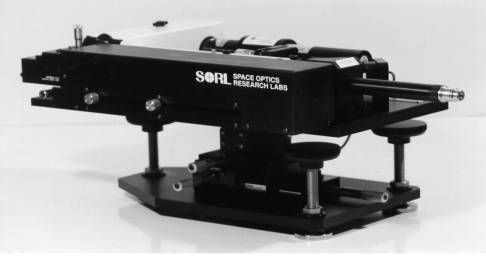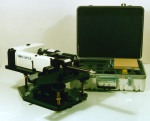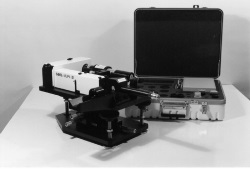LUPI-II Systems

The laser unequal pathlength interferometer is a portable, precision instrument for testing and aligning optical components and systems. It can serve as the primary inspection tool for in-process optical fabrication and final quality certification. It is very compact and portable, yet extremely stable and is adaptable to most component or system tests, including coated and uncoated optics in reflection or transmission.
The SORL LUPI Interferometer can easily be modified for phase shifting. For such an application a piezo operated flat can simply be placed and mounted in front of the permanent reference flat. The piezo induced phase shift in conjunction with the appropriate camera provides fringe analysis and interferogram interpretation.
This software supported fringe analysis system is available as an option. It permits mapping and averaging, wavefront scanning, fringe fitting, and subtraction of aberrations and polynomials.
Laser Unequal Pathlength Interferometer After reflecting off the mirror being tested and reaching the reference flat, light is retro reflected. It retraces its path through the focal point and back to the beam splitter. In lens testing, beams collimated from the focal point also reach the reference flat and retrace their paths back to the beam splitter At the beam splitter, the two beams of light recombine. Through constructive and destructive interference of the light waves, a pattern of light and dark fringes are formed. These are observed by the camera and fed to a video screen. The fringe pattern reveals the shape of the test piece and any errors that may be present. It can also be used to determine the focal length and off axis conditions. The SORL LUPI Interferometer can easily be modified for phase shifting. For such an application a piezo operated flat can simply be placed and mounted in front of the permanent reference flat. The piezo induced phase shift in conjunction with the appropriate camera provides fringe analysis and interferogram interpretation. This software supported fringe analysis system is available from DURANGO SOFTWARE. It permits mapping and averaging, wavefront scanning, fringe fitting, and subtraction of aberrations and polynomials. * Space Optics Research Labs does not recommend the classic "View with an eyepiece"approach. Possible eye damage may occur when using an eyepiece to observe interferograms. Observe proper laser safety practices. Eyepieces are supplied for image projection not visual use. Fringe Analysis System featuring DURANGO SOFTWARE This is a powerful tool for testing in Application and Research and Development Laboratories and for Optics Fabricator Shops. Its simple and precise operation provides for fast fringe analysis. Permits quality control of most demanding optical components. Phase shift analysis can be routinely performed. The contour map and phase height profile shown depict typical phase shift data obtained with a LUPI operating with a Fringe analysis system from DURANGO SOFTWARE Calibration Sphere with Mount For calibrating the laser unequal pathlength interferometer: · 2.5" (75 mm) Diameter, 2.5" (64 mm) Radius of Curvature, *Space Optics Research Labs does not recommend the classic "View with an eyepiece"approach. Possible eye damage may occur when using an eyepiece to observe interferograms. Observe proper laser safety practices. Eyepieces are supplied for image projection not visual use. Permits measurement of cone angles from f/2 to f/20 Additional SORL components to create measuring systems.LUPI Description
The LUPI is a Twyman-Green type interferometer. In this type of instrument, light coming from the laser source is spatially filtered, collimated and passed through a beam splitter. Half of the light is reflected by the beam splitter and directed to a reference flat. The other half of the light passes through the beam splitter and is tightly focused. This focal point is also the focal point of an object being tested, such as a lens or a mirror.
Sample Tests
LUPI Systems

Laser Unequal Pathlength Interferometer (LUPI)
Custom Instrument and Accessory Case
· 2 mW laser, 0.6328 micron wavelength, polarized
· Fully adjustable x-y-z control — precise micrometer positioning
· Tests both focal and afocal telescope systems
· Compact, portable: 18" L x 10.1" W x10.1"H
(460 mm L x 260 mm W x 260 mm H)
· Weight: 47 lbs. (23 kg)
· Cone Angle Range: f/2 - f/8 Stand, (f/1 - f/20 optional)
· Microscope Objective Lens: 10X, V2, 0.25 N.A.
· Imaging Lens, Matched to Objective
· Objective Lens Extension Tube, 6" (150 mm) Long
· Eyepiece *
· Complete—Custom Instrument and Accessory Cases

(CSP™)
l / 20 P-V (l = 0.6328 microns) Surface Accuracy
· Cell-Type Mount, Adjustable Tip and Tilt
Accessory Kit (AK-I™)
· Microscope objectives (3), including interferograms
· Matching imaging lenses (5)
· Objective extension tubes, 4/10" (10 mm) to 3" (75 mm)
long (4)
· Eyepieces
· Flat Mirrors (Test Flats)
· Spherical Mirror (Hindle Spheres)
· Mirror Mounts